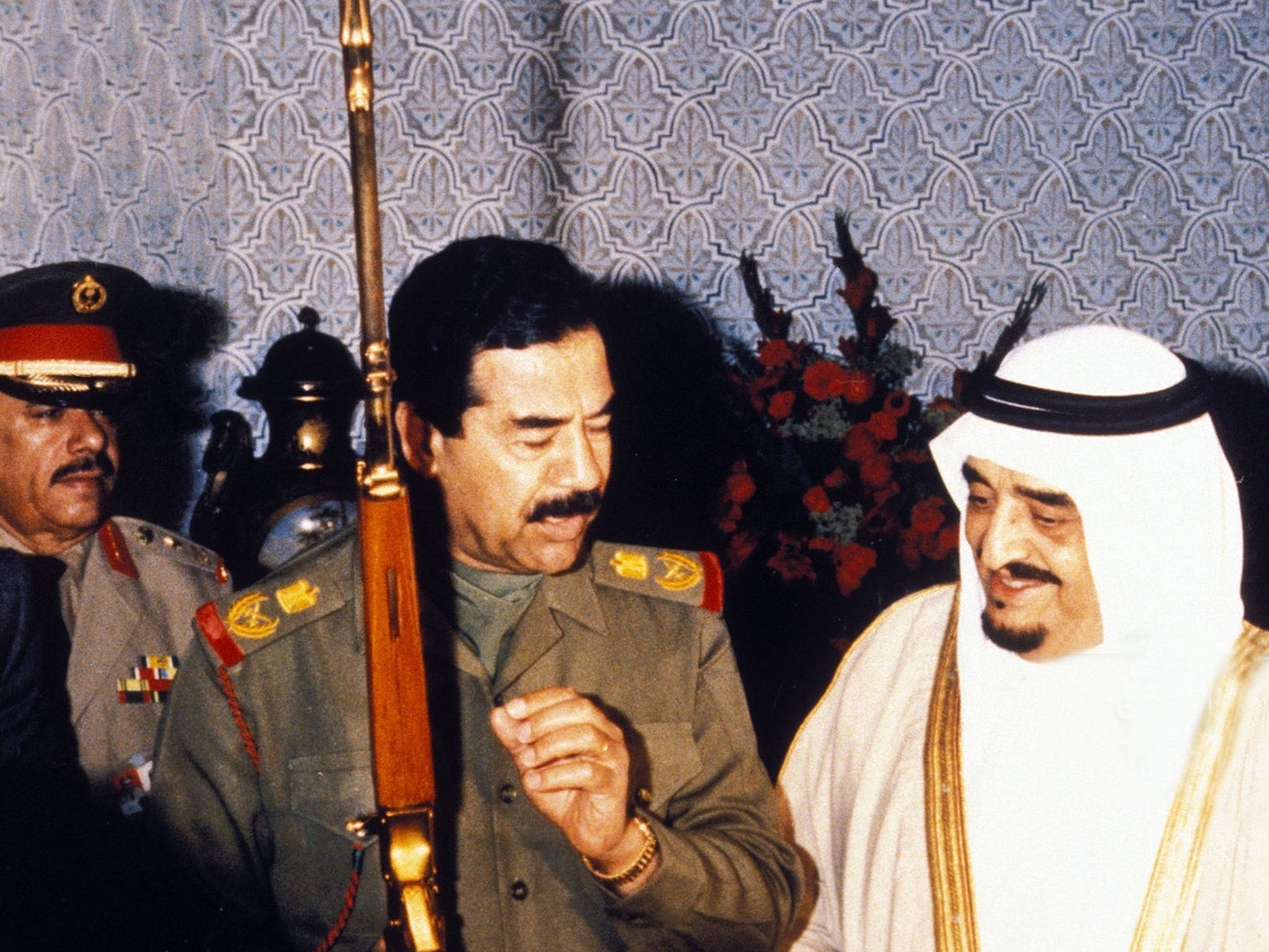Profiles
The leaders of Iraq, America, Saudi Arabia, and Kuwait were the key figures in the dramatic events of 1990-91

Saddam Hussein and King Fahad, before the invasion of Kuwait.
Saddam Hussein
Born in 1937 near Tikrit in Iraq’s Sunni heartland, Saddam Hussein was president of Iraq from 1979–2003.
He joined the Baath Party in 1957, and in 1959 participated in an unsuccessful attempt to assassinate then Iraqi prime minister Abdul Karim Qasim. Saddam fled first to Syria, and then to Egypt, attending law school in Cairo. He returned to Iraq in 1963 when the Baathist took power. But the party was overthrown that same year.
He was a key figure in the coup that brought the party back to power in 1968. Saddam emerged as a co-leader of Iraq along with President Ahmad Hasan Al Bakr, and in 1979, took control of the country as president.
His invasion and occupation of Kuwait, after his invasion and eight-year war with Iran, led to a crippling trade embargo against Iraq. The country’s total defeat by the US-led coalition triggered internal rebellions by Shiites and Kurds, which the regime put down with trademark brutality.
After the September 11 attacks in the United States in 2001, Washington decided to topple Saddam, though Iraq did not have anything to do with the Al Qaida terrorists who targeted America.
On March 17, 2003, US President George W. Bush gave Saddam Hussein an ultimatum to step down from office and leave Iraq within 48 hours or face war. When he refused to leave, US and allied forces launched an attack on Iraq on March 20. After an extreme bombing campaign of ‘shock and awe’, Iraqi defences collapsed and Baghdad fell on April 9 to US soldiers. Saddam went into hiding but was captured on December 13, 2003.
In October 2005 Saddam went on trial and was sentenced to death next year. He was executed on December 30, 2006.
George H.W. Bush
George Herbert Walker Bush, born in 1924 was the 41st president of the United States (1989–93). As president, Bush led a multinational military effort to push occupying Iraqi forces out of Kuwait in the Gulf War. His time in office coincided with major world events, including the collapse of the Soviet Union and the reunification of Germany.
But his most important diplomatic victory was assembling and leading a large international coalition of western European and Arab states against Iraq. The allied offensive led to total victory over Iraqi forces, which were decimated under the sheer weight of US firepower. Bush’s war restored Kuwait’s independence.
Following the victory over Iraq, his approval rating reached 90 per cent but the economic recession that followed dampened this support considerably.
This popularity soon waned, however, as an economic recession that began in late 1990 persisted into 1992. The fact that Bush had reneged on his famous “read my lips” no taxes pledge and raised taxes to tackle the burgeoning budget deficit raised the ire of conservatives.
He lost to Bill Clinton by a popular vote of 37 per cent to Clinton’s 43 per cent. Third-party candidate Ross Perot garnered 19 per cent. Despite winning a major war, Bush was unable to win re-election. He died in 2018.
King Fahad Bin Abdul Aziz
King Fahad Bin Abdul Aziz’s rule over Saudi Arabia (1982 to 2005) was marked by a series of important world events, like the Soviet occupation of Afghanistan, the Iran-Iraq war and, most importantly, the Gulf War.
He deftly steered Saudi Arabia through all these challenges. The liberation of Kuwait was plainly a result of King Fahad’s decision to invite US troops to the Arabian Peninsula, a decision that was met with some opposition in the region.
He allowed coalition forces to use Saudi Arabia as a base of operations during the Gulf War, and paid for the major share of the conflict.
Fahad was born in 1923, nine years before his father, Abdul Aziz ibn Saud, founded Saudi Arabia by uniting the people of the Arabian Peninsula under one banner.
Having held a series of important ministerial posts in the previous decades, Fahad became the monarch upon the death of his brother King Khalid in 1982. Three days after Iraq’s invasion of Kuwait, King Fahad met US Secretary of Defence Dick Cheney in Riyadh, who urged him to act fast if he wanted US help.
After quick discussions with his advisers, Fahad gave the green light for the arrival of US troops in the Kingdom. In a matter of weeks, about 600,000 Western and Arab troops arrived in the Kingdom, which was to become the launchpad for the allied war effort. In 1995 King Fahad suffered a major stroke, and gradually the day-to-day running of the kingdom fell to his brother Crown Prince Abdullah Bin Abdul Aziz, who became king upon Fahad’s death in 2005.
Sheikh Jaber Al Ahmed Al Jaber Al Sabah
Born in 1926, Sheikh Jaber Al Ahmed Al Jaber Al Sabah became the Emir of Kuwait in 1977, having held a series of important posts, including that of Prime Minister, before.
He became a household name around the world following Saddam Hussein’s aggression against his country. Two years after he became Emir, the Islamic Revolution toppled the Shah in Iran, and sent shockwaves across the Gulf.
Soon, the Iran-Iraq war broke out and, officially at least, Kuwait managed to stay neutral while secretly giving financial assistance to Iraq.
This was despite the fact that there had been many terrorist attacks in Kuwait, including an attempt on Sheikh Jaber’s life, blamed on pro-Iranian groups in Kuwait. After the Iraqi invasion, Sheikh Jaber famously touched his head to the ground upon his return to Kuwait on March 14, 1991.
However, he found a country left in ruins by the occupiers, with its oil wells burning. The reconstruction of of his country cost $100 billion, spent over several years.
The emir gave public support for the rights of women but in 1999 his decree to grant women the right to vote was rejected.
It was not until 2005 that women were given the right to vote and stand in parliamentary elections. In 2001 Sheikh Jaber suffered a stroke and thereafter carried out virtually no public activities. He went to Britain for treatment. He died on January 15, 2006, aged 79.



